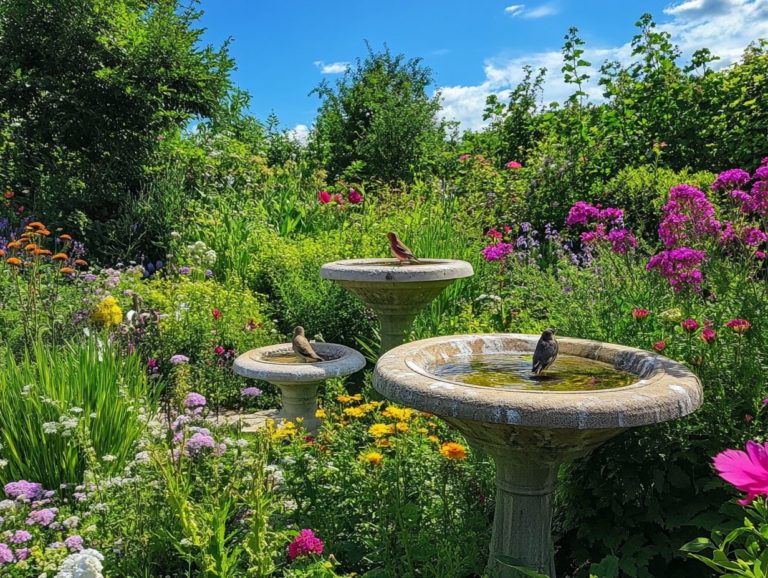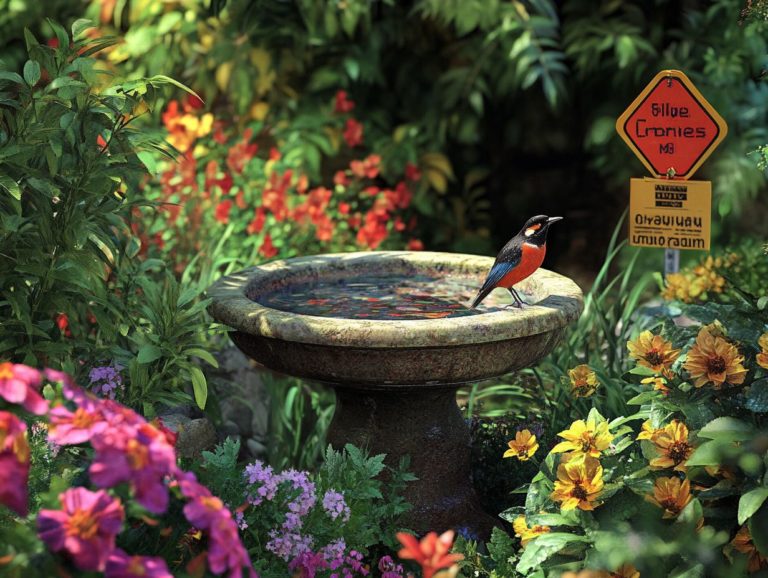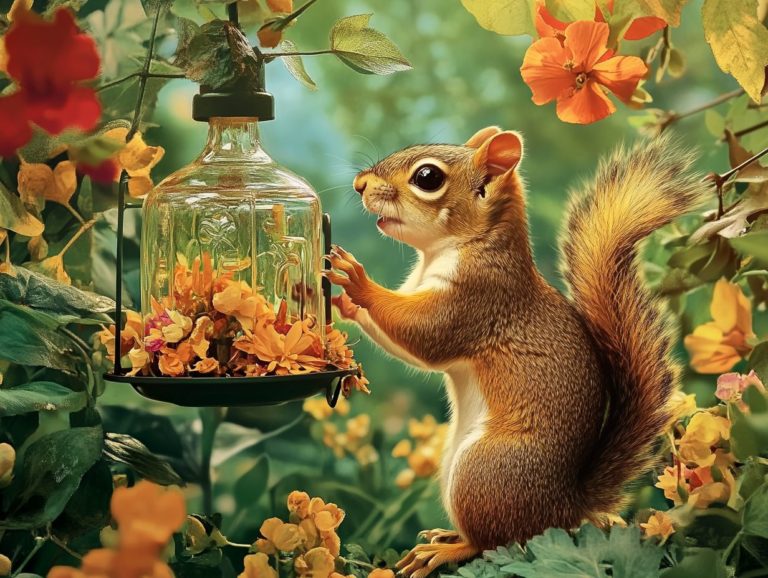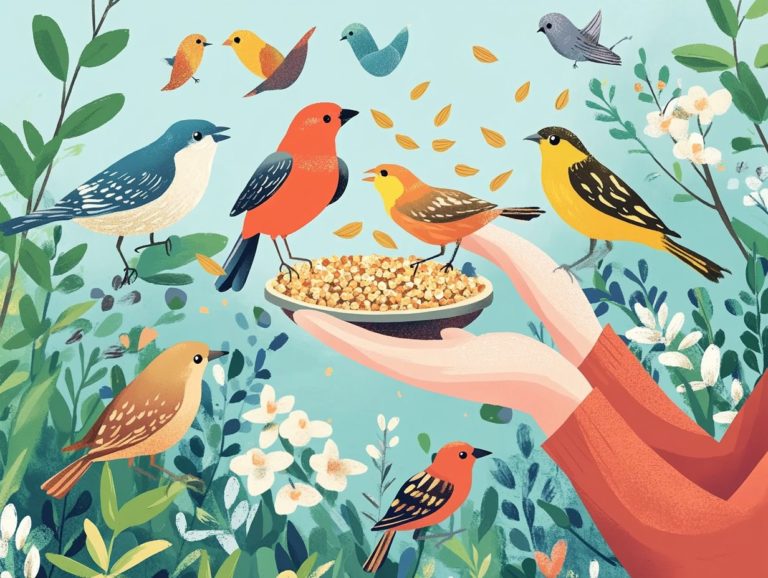Best Bird Bath Plants to Surround Your Bath
A vibrant garden around your bird bath transforms your outdoor space into a sanctuary for birds and visitors.
Imagine stunning flowers that catch the eye and pleasant-smelling plants that fill the air with delightful fragrances. The right selections significantly enhance your garden’s beauty and functionality.
This article explores various plants that attract birds while adding texture, color, and interest to your landscape.
Discover the best plants to surround your wildlife garden, turning it into a thriving haven for wildlife and a visual delight for you and your guests!
Contents
- Key Takeaways:
- 1. Attractive and Colorful Flowers
- 2. Plants with Fragrant Blooms
- 3. Plants with Berries or Fruits
- 4. Plants with Interesting Foliage
- 5. Plants That Attract Birds
- 6. Plants That Provide Shade and Shelter
- 7. Low-Maintenance Plants
- 8. Native Plants
- 9. Plants That Attract Butterflies and Bees
- 10. Drought-Tolerant Plants
- 11. Evergreen Plants
- 12. Plants That Can Withstand Wet Soil
- 13. Plants That Repel Pests
- 14. Climbing or Vining Plants
- 15. Plants That Add Texture to the Garden
- Frequently Asked Questions
Key Takeaways:
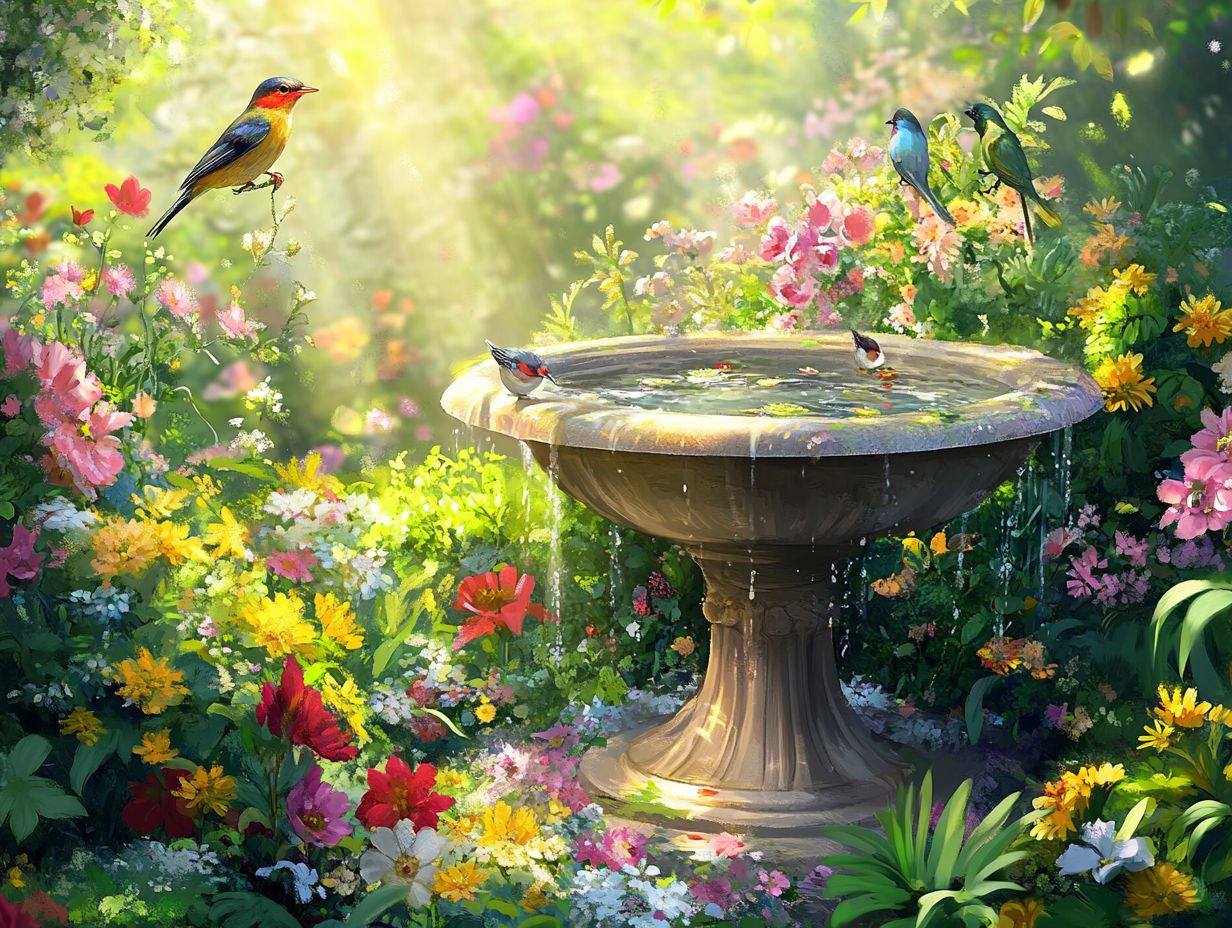
1. Attractive and Colorful Flowers
Creating an enchanting garden space requires colorful flowers that elevate visual appeal and nurture local wildlife. By selecting vibrant plants, you can transform your garden into a sanctuary brimming with beauty and life.
As spring unfolds, embrace flowering annuals like petunias and marigolds, bursting with lively colors. In summer, showcase perennials such as coneflowers and black-eyed Susans, returning year after year with radiant hues.
Autumn adds charm with the warm tones of chrysanthemums and asters, offering a breathtaking farewell to the growing season. Enhance these blooms with birdbaths and decorative accents to invite songbirds and pollinators, crafting a harmonious community of plants and animals.
These elements elevate your garden s design and serve as delightful focal points, enriching your experience of observing nature up close.
2. Plants with Fragrant Blooms
Incorporating plants with fragrant blooms into your garden adds a visual feast and transforms it into a pleasant-smelling garden.
Consider plants like lavender and rosemary; they release soothing scents that evoke cherished memories. Annuals such as sweet alyssum and nasturtium attract a vibrant array of pollinators, including bees and butterflies.
Imagine a stroll through a garden filled with the intoxicating aroma of jasmine or refreshing scent of mint. Each fragrant plant contributes to a sensory tapestry, making your garden a sanctuary for the senses.
3. Plants with Berries or Fruits
Integrating plants that bear berries or fruits enhances visual appeal while nourishing birds and other wildlife, fostering a vibrant ecosystem in your outdoor living space.
Select varieties suited to your climate to elevate your garden’s ecological value. Consider plants like blueberries or elderberries; these thrive in acidic soils and tolerate partial shade.
Fruit-bearing trees, such as crabapple and cherry, offer delightful treats for local fauna and attract essential pollinators, enriching your garden’s biodiversity. Including these plants supports wildlife and deepens your connection to nature, making gardening truly rewarding.
Start designing your dream garden today and attract beautiful wildlife!
4. Plants with Interesting Foliage
Intriguing foliage is vital for your garden design. It adds texture and visual appeal, transforming your outdoor space.
Consider the diverse types of foliage: the striking dark leaves of ornamental kale or the vibrant variegation of coleus. These elements create stunning contrasts that elevate your garden’s aesthetic.
Imagine the cool greens of hostas beautifully complemented by the fiery reds and yellows of seasonal flowers. Bold succulents introduce striking architectural lines.
This lets you create a stunning garden theme that flows beautifully, whether it leans towards the formal or the whimsical.
5. Plants That Attract Birds
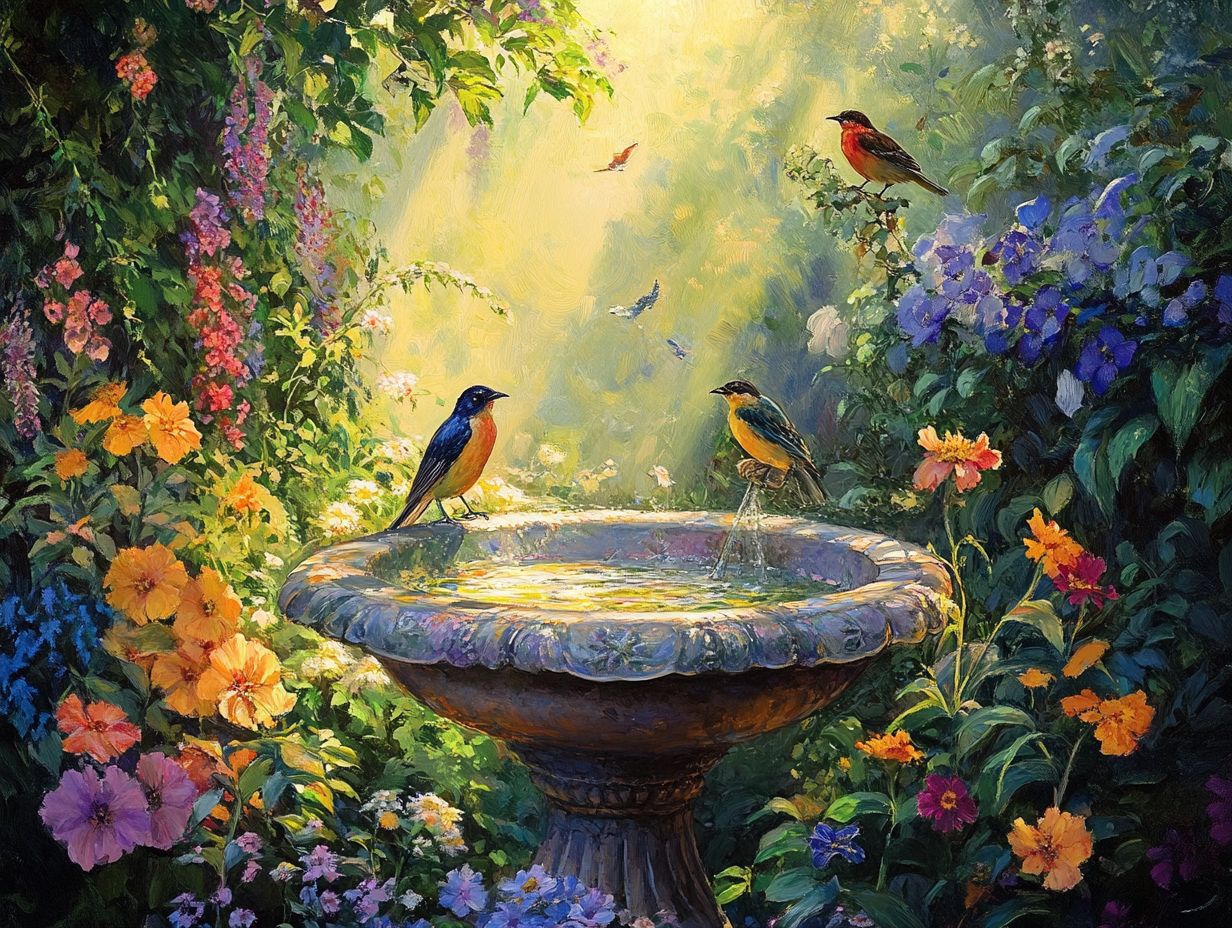
Selecting plants that attract birds is a key part of your garden design. It elevates your outdoor living experience by creating a vibrant wildlife sanctuary that nourishes and shelters your feathered guests.
Incorporate berry-producing varieties like elderberry, holly, and serviceberry. These plants serve as essential food sources during migration and winter months.
Native plants such as coneflowers and sunflowers draw in birds with their seeds. They also provide support for local pollinators.
Enhance this delightful ecosystem by strategically placing bird feeders stocked with seeds, suet, or nectar. This transforms your garden into a serene haven, allowing you to enjoy charming interactions between birds and their surroundings.
6. Plants That Provide Shade and Shelter
Plants that provide shade and shelter are essential for crafting a diverse and functional garden design. They offer refuge to wildlife while enhancing your outdoor space with their inherent beauty.
Incorporate a mix of trees and large shrubs to block harsh sunlight. This creates vital habitats for birds, insects, and other creatures.
Imagine towering canopies from species like oak, maple, and birch, interspersed with the vibrant colors and textures of flowering shrubs such as lilac or hydrangea. These plants invite nature into your garden.
To maximize the benefits of these leafy allies, consider clustering them together to form a natural oasis. This encourages biodiversity and creates inviting nooks for relaxation and outdoor activities.
Ensure your garden becomes a haven of tranquility and life.
7. Low-Maintenance Plants
Incorporating low-maintenance plants into your garden design allows you to enjoy a stunning outdoor space without burdensome upkeep. They are perfect for busy gardeners and those looking to create a drought-resistant haven.
Resilient varieties like succulents, native grasses, and ornamental shrubs typically require minimal watering and thrive in diverse soil types.
Succulents flourish in well-draining soil, making them ideal for rock gardens or stylish containers. Native grasses easily adapt to local climates, enhancing garden themes from sleek modern landscapes to charming rustic retreats.
By integrating these plants, you cultivate a beautiful, effortless aesthetic while contributing to sustainable gardening practices. This promotes biodiversity and reduces water consumption.
Their adaptability ensures your garden remains vibrant throughout the seasons, all while demanding little of your time and attention.
8. Native Plants
Choosing native plants for your garden is a powerful way to protect the environment while supporting local wildlife. Don’t miss out on creating a beautiful wildlife haven that showcases the allure of indigenous flora.
Native plants are those that naturally grow in your region. They are naturally attuned to your local climate and soil, which means they require less water and fewer chemical inputs than non-native counterparts. This adaptability reduces your garden maintenance and fosters a resilient ecosystem that thrives with minimal interference.
Local nurseries often offer a variety of native species, from vibrant wildflowers that attract pollinators to sturdy shrubs that provide cozy shelter for birds and small mammals. By incorporating these plants, you actively contribute to enhancing biodiversity and maintain healthy habitats for various species while enjoying the fascinating sight of local fauna visiting your yard.
9. Plants That Attract Butterflies and Bees
Incorporating plants that attract butterflies and bees not only elevates your garden’s beauty but also nurtures a vibrant wildlife sanctuary. These plants support essential pollinators in your outdoor living space and utilize potting soil formulated for their needs.
These plants serve as vital food sources for delightful creatures, promoting biodiversity and fostering ecological balance. Imagine adding vibrant coneflowers and fragrant lavender to create a sensory haven that draws in bees and butterflies. Marigolds, with their cheerful blooms, infuse your garden with color while keeping pesky intruders at bay.
Craft striking contrasts by thoughtfully integrating these flowering plants into various garden designs whether cottage-style charm or sleek modern minimalism. This intentional planting transforms your space and enriches local ecosystems, ensuring your garden thrives as a celebration of nature’s beauty.
10. Drought-Tolerant Plants
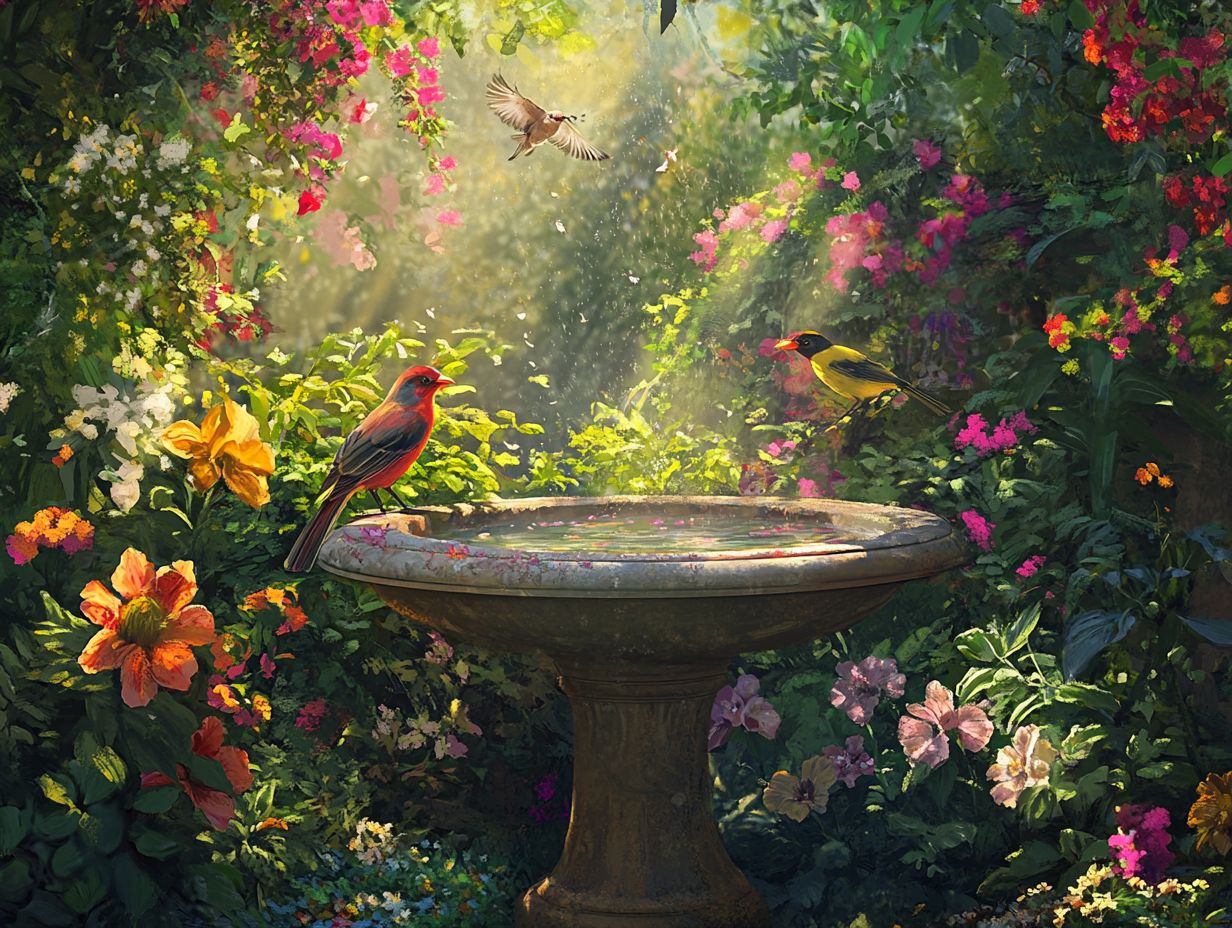
Drought-tolerant plants are an exceptional choice for your modern garden design, offering beauty and resilience while requiring minimal watering. This makes them perfect for embracing a sustainable outdoor lifestyle.
These plants thrive in various growing conditions, allowing them to seamlessly integrate into a range of garden themes, from Mediterranean-inspired landscapes to vibrant succulent displays. By incorporating these species, you elevate the aesthetic appeal of your space and significantly reduce overall water consumption and maintenance time.
If you’re seeking vibrant blooms or lush green foliage without the constant watering hassle, consider exploring a diverse selection of drought-resistant options. Choosing the right combination of these resilient plants creates stunning visual contrasts and seasonal interest while conserving resources, making them a savvy investment for eco-conscious homeowners.
11. Evergreen Plants
Evergreen plants are essential in your garden design, offering year-round greenery that enhances the beauty of your outdoor living spaces, regardless of the season.
These resilient plants provide a stable backdrop and enhance the overall structure of your garden, adding layers and depth. Varieties like spruces and pines retain their foliage throughout the winter, ensuring your landscape remains vibrant and alive. Hardy shrubs like boxwoods or hollies add an air of formality and elegance.
By incorporating evergreens alongside seasonal plants, you can create dynamic seasonal displays. Picture blooming perennials or annuals bursting forth around the solid bases of these steadfast plants, maintaining a cohesive theme throughout your landscape.
12. Plants That Can Withstand Wet Soil
Incorporating plants that thrive in wet soil is essential for creating an effective garden design, especially in areas that experience heavy rain or high moisture levels. This approach ensures that your outdoor living space flourishes.
By selecting the right varieties, you’ll love how vibrant and diverse your garden can become! For instance, native marsh marigolds and striking blue flag irises can enhance the charm of a traditional water garden. Their ability to thrive in damp conditions makes them perfect for such settings.
These plants adapt beautifully to poorly draining soil and offer benefits by attracting pollinators and wildlife, helping nature thrive. When you integrate wet-tolerant plants thoughtfully, they can complement various garden themes.
This enriches the overall landscape design and creates a harmonious outdoor environment.
13. Plants That Repel Pests
Integrating plants that repel pests into your garden design elevates both its aesthetic appeal and functionality. These plants create a natural barrier against unwanted insects while fostering a healthy outdoor living environment.
Take lavender, for example. It not only exudes a calming fragrance but also effectively deters moths and mosquitoes, adding a delightful splash of purple to your garden.
Marigolds are celebrated for their vibrant blooms and have a well-earned reputation for warding off tiny worms that can harm plants and other crop-threatening insects.
Then there’s rosemary, which enhances the flavor of your culinary creations while acting as a formidable defense against pests like aphids and cabbage moths. By choosing these herbs and showcasing their ornamental qualities, you can transform your garden into a harmonious sanctuary that thrives naturally, free from chemical interventions.
14. Climbing or Vining Plants
Climbing or vining plants are an exceptional addition to your garden design, infusing vertical beauty and allowing for creative decorative accents that elevate your outdoor living spaces.
These plants can be particularly transformative, turning dull walls or fences into lush, green masterpieces while also serving practical purposes. In sun-soaked areas, consider options like clematis or honeysuckle. Their vibrant blooms and delightful scents create a stunning focal point.
For shadier spots, varieties such as ivy or sweet autumn clematis thrive beautifully. They effectively conceal unsightly structures and add a layer of privacy to your intimate seating areas.
By selecting the right climbing plants for your specific conditions, you can enhance the aesthetics of your outdoor space while fostering rich biodiversity.
15. Plants That Add Texture to the Garden
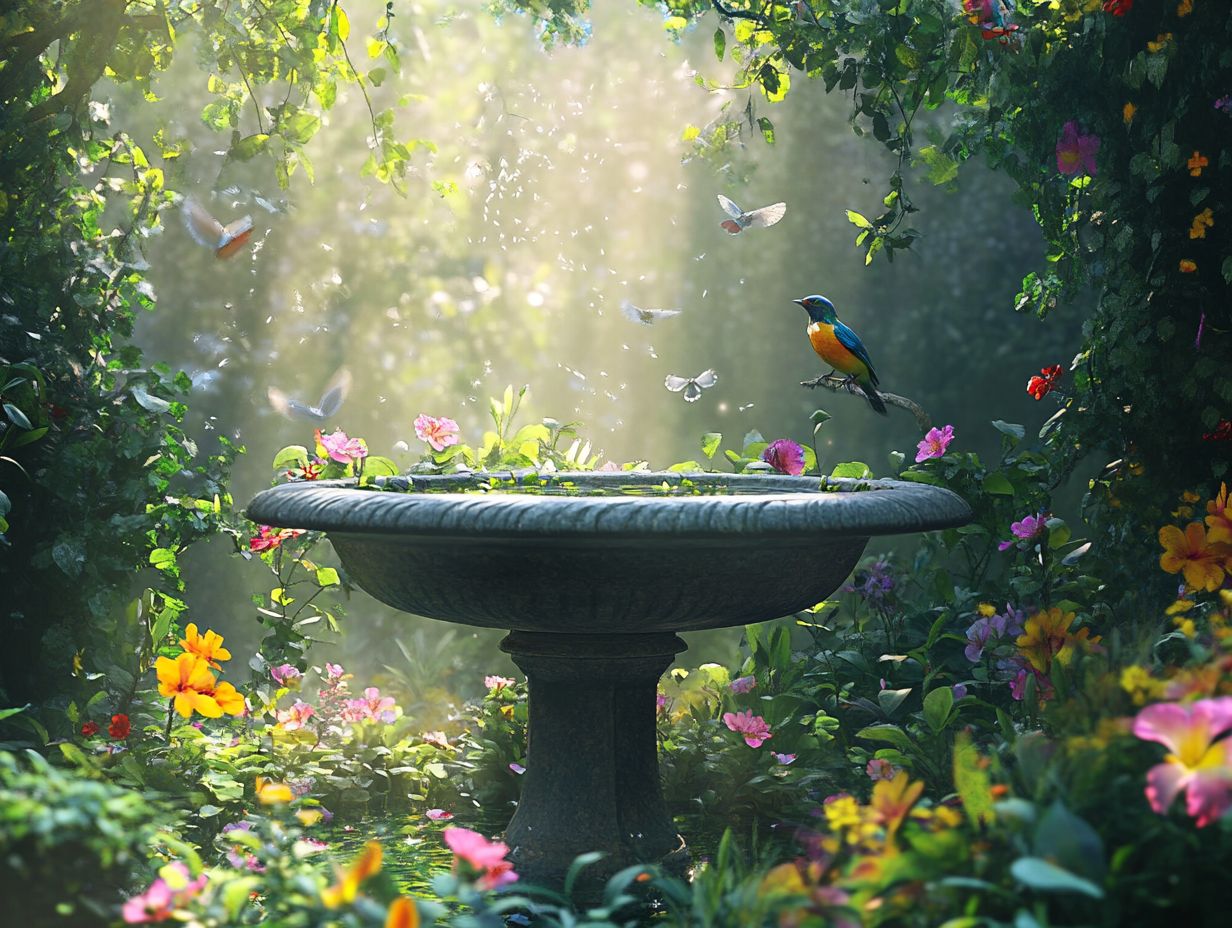
Incorporating plants that add texture to your garden creates a captivating outdoor experience, enriching your sensory engagement with a delightful assortment of leaf shapes and sizes.
By selecting specimens such as the feathery fronds of ferns, the s succulent leaves of echeveria, and the bold, spiky silhouettes of ornamental grasses, you can craft an engaging tapestry that draws the eye and invites curiosity.
Mixing and matching these species creates a dynamic visual interplay that beckons exploration and adds depth to the landscape. For instance, the soft, lush texture of lamb s ear pairs beautifully with the striking form of yucca.
The smooth leaves of hostas serve as an ideal backdrop for the jagged edges of shutters or thistles. Together, these elements transform traditional gardens into vibrant, living mosaics that reflect your unique aesthetic.
Frequently Asked Questions
What are the best bird bath plants to surround your bath?
Some good options for bird bath plants include ferns, hostas, hydrangeas, and lilies.
Why are these plants beneficial for a bird bath?
These plants provide a natural, inviting environment for birds to come and drink or bathe in the water. They also provide shade and shelter for the birds.
Get started today and transform your outdoor space!
Do these plants require a lot of maintenance?
Not necessarily! These plants are low maintenance, needing minimal watering and pruning.
Can these plants attract wildlife besides birds?
Yes! They can also attract beneficial insects like butterflies and bees, enhancing the beauty of your bird bath area.
Do these plants have specific planting needs?
Most prefer soil that stays slightly damp but isn’t soggy. Some may thrive in partial shade.
Be sure to check the specific needs of each plant to ensure they thrive!
Are there plants to avoid near a bird bath?
Avoid plants toxic to birds, such as lilies of the valley and oleander. Also, steer clear of plants that attract pests like mosquitoes.

